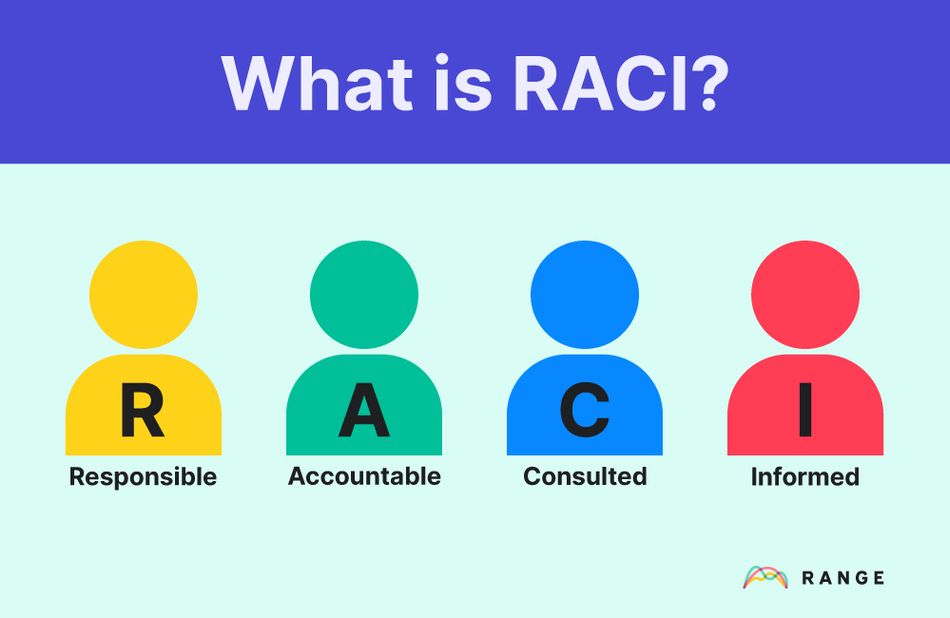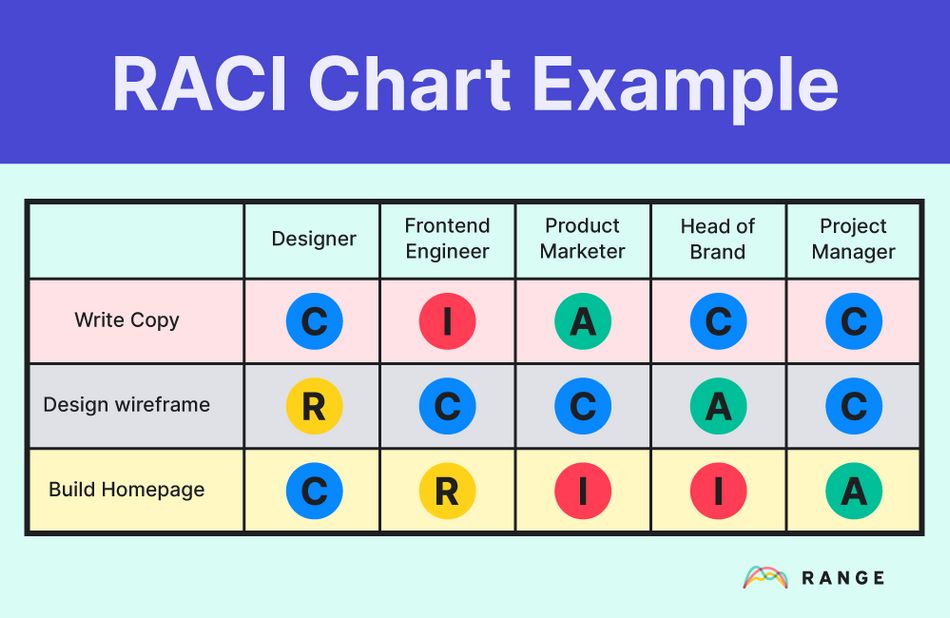Projects don't progress in a vacuum.
There are starts, stops, milestones, and obstacles included in the journey. Helping the project participants understand the part they play (and the ones they don't) smooths out conflicts and keeps everyone trucking along efficiently.
To make this happen, many businesses rely on the RACI model: responsible, accountable, consulted, informed.
Your company may be experts at identifying two or three of these components, but fall short on the fourth.
To efficiently complete projects, streamline the process, and ensure participants clearly understand their responsibilities, all four of these components need to be in place. This is where the RACI responsibility assignment matrix shines.
Below, we break down the definition of a RACI model, how to create one that works, and some additional guidelines to follow for agile project management.
Read on for a deeper understanding of how to use RACI charts to empower your stakeholders, break down silos, and increase the quality of your deliverables.
Explaining the RACI responsibility assignment matrix
What is the RACI assignment matrix? The RACI responsibility assignment matrix chart gives project managers a way to build a blueprint of the tasks and actions involved in a project. There are four main parts a person who is involved in the project may play:
- Responsible (R): These team members are the project’s workhorses. They are the ones in the trenches who must complete the tasks. There may be more than one responsible stakeholder.
- Accountable (A): This person is involved in the decision-making. The accountable party reviews the finished work to ensure quality — and that it’s indeed finished. Increasing team accountability is key in moving projects forward.
- Consulted (C): A team member who functions as part of the project team by offering expertise on part of the project may be consulted for guidance and advice. These are typically your company's subject matter experts.
- Informed (I): While not being a contributor or a part of the decision-making process, these participants need to be kept apprised of the project’s progress. These team members need broad explanations — not every minute detail about the tasks involved.

To succeed in project management, everyone’s roles need to be well defined. Projects are too expensive to not be managed effectively. Wasted time and energy means wasted money. The survey results for the 2020 Pulse of the Profession reveal that an average of 11% of investment is wasted due to poor project performance. The RACI responsibility assignment matrix showcases the project’s main goal and what each participant is tasked with completing.
4 steps for creating a RACI matrix for effective project management
It’s not difficult to create a RACI matrix to help manage your projects and assist the participants in understanding their project roles. You will, however, need to do some information gathering and brainstorming on the front end before you attempt to put it all together. The more thorough you are when you flesh out the plan, the better the RACI matrix will perform. Here are the four main steps for creating a RACI matrix.
1. Identify all the key tasks and stakeholders involved
Think about the project from its conception until the final sign off. Make two columns in a spreadsheet. In the left-hand column, add all the project tasks required to move the initiative forward. List these tasks the way they’ll be completed during the project, from first to last. This column needs to hold things like research, meetings, interviews, feedback, and any other tasked-based action involved in the project.
On the top row of the project plan, add all the team members who will play a part in the project. Include the project sponsors, planners, executors, decision makers, managers, reviewers, and anyone else who is directly or indirectly involved.
2. Fill the model cells with stakeholders
Go down the chart and start matching up tasks with stakeholders. In the corresponding cells of the chart, designate who is responsible for, accountable for, will be consulted about, and will be informed about this specific step of the project.
This is the step in the process that makes sure nothing falls through the cracks. There needs to be at least one team member responsible for every task on the chart. There should also be one accountable person for every line item.
Using this template puts the assignments in black-and-white, helping every project stakeholder clearly understand the expectations. As they dig into the project, there will be less confusion about who is supposed to be handling what.

3. Double-check cells and make sure every task has a stakeholder
After you fill the cells, look over the chart closely before you share it with the participants. Every task needs to have a stakeholder assigned to it. The RACI matrix lets you easily see gaps in the plan that wouldn’t be as visible with other charts.
Make sure you have enough stakeholders involved. If a few people are overloaded, this could damage the chances of project success. You may consider moving some tasks off stakeholders who are bearing a large part of the project and giving those tasks to others who have fewer assignments.
It won’t be perfect on the first shot. Adjust the RACI matrix chart until you feel it will be a helpful project management tool for your team.
4. Share your RACI matrix with the team and ask for feedback
A RACI chart isn’t one-way communication. The stakeholders need to have buy-in, which makes it important to show them the chart and ask for their opinions. Go over the work breakdown structure you’ve outlined and see if every participant agrees to the particular tasks that involve them. They need to acknowledge and understand the part they play, the timelines, and what success looks like.
Keep in mind that some of your stakeholders may be remote. Make sure they're included in these conversations and kept in the loop with both real-time and asynchronous communication tools. An open conversation about the plan before the project starts unearths potential issues and avoids time-consuming conflicts and roadblocks once the initiative is rolling.
5 Important RACI matrix guidelines to follow for agile project management
Creating a RACI matrix for your agile team to understand the way you expect them to contribute to a project is a wise business decision. Giving them a way to see the granular parts of a project promotes efficiency and minimizes the risk of the project getting bogged down with misunderstandings and vague guidance.
While a RACI matrix is a straightforward methodology, you can still make mistakes or overlook issues that can cause the project to stumble. Project managers should keep the following four guidelines in mind to create the most successful RACI matrix possible.
1. Make sure to assign the right amount of RESPONSIBLE people
You may have more than a single responsible person for certain tasks on your RACI chart — and that’s okay. Just make sure it’s necessary. If too many people are responsible for the same task, this can bite you with wasted time. Each responsible party may end up duplicating the work of the other. They may have conflicts about how to accomplish their shared tasks.
If you notice that you’ve assigned quite a few tasks with multiple responsible people, consider breaking those tasks down more granularly if you can. Then you can assign a single person to be responsible for each one.
2. Designate one ACCOUNTABLE person for each task
Have you ever heard the saying “too many cooks in the kitchen?” Well, that’s the same dynamic at play here.
Never assign more than one accountable person to a specific task, or you’re asking for trouble. For example, if there are two stakeholders responsible for accountability, they will likely have different ideas of how to complete the deliverable. They may have conflicts about whose way is best and may even end up in gridlock. Other stakeholders must then take time away from their tasks to get involved and sort out the situation.
Another example of more than one accountable person would be each one thinking the other one is handling certain details, and neither of them is. This can leave tasks undone and may hold up the entire project.
The bottom line, you only need one person accountable for every task on your RACI chart.
3. Limit how many CONSULTS you have
While it’s good to have some team members consult on the project and its tasks, avoid assigning too many to a specific task. Everyone has their way of doing things. If there are multiple people giving advice, chances are good they aren’t going to agree on everything. Different ideas can be time consuming to sort through.
When you assign your RACI roles, narrow down the people you designate to consult to the truly necessary ones. You can proactively mitigate issues by avoiding overlap.
4. Keep important stakeholders INFORMED
There will be people in your organization that want to be apprised of the project’s progress. Make this communication a priority. Even though they aren’t playing other roles, it’s vital for the stakeholders who have a vested interest in the project to get regular status updates.
These participants probably don’t care about every little detail of the project. When you inform them, stick to the key points of success, if and where the project is stalled, and what actions are next on the agenda. This high-level view makes sure they’re in the loop without bogging them down in unnecessary details.
5. Keep your team organized and in the know with Range
When managed wisely, organizing projects with a RACI matrix chart decreases unnecessary back and forth, increases the effectiveness of the team’s communication, helps avoid double work, cuts down on conflicts, and gives everyone a clear picture of their tasks.

Savvy project managers understand the importance of using team communication tools to keep initiatives on track on communication flowing. In fact, 25% of respondents don’t have the right technology to enable team collaboration. Range is a collaborative tool that functions both in real time and asynchronously, ensuring every stakeholder has the information they need to do their best work.
Want to know more about how Range can elevate your team’s performance and contribute to your next project’s success?








